A Word Document for Online Assessment
VerifiedAdded on 2022/08/20
|14
|5302
|24
AI Summary
1.2 Bioethics: Bioethics is referred to as the ethical concerns that arises in the field of biology and medicine applied to healthcare(Tiegreen, 2020) 1.3 Nursing ethics: Ethics that are applied during the activities in nursing practice that builds up a caring relationship between the patient and the nurse (Zahedi et al., 2013). 3.1 Consequentialism: An ethical theory that critiques right or wrong conduct based on the consequences of selecting an action increases good consequences based on two principles- utilitarianism stating
Contribute Materials
Your contribution can guide someone’s learning journey. Share your
documents today.
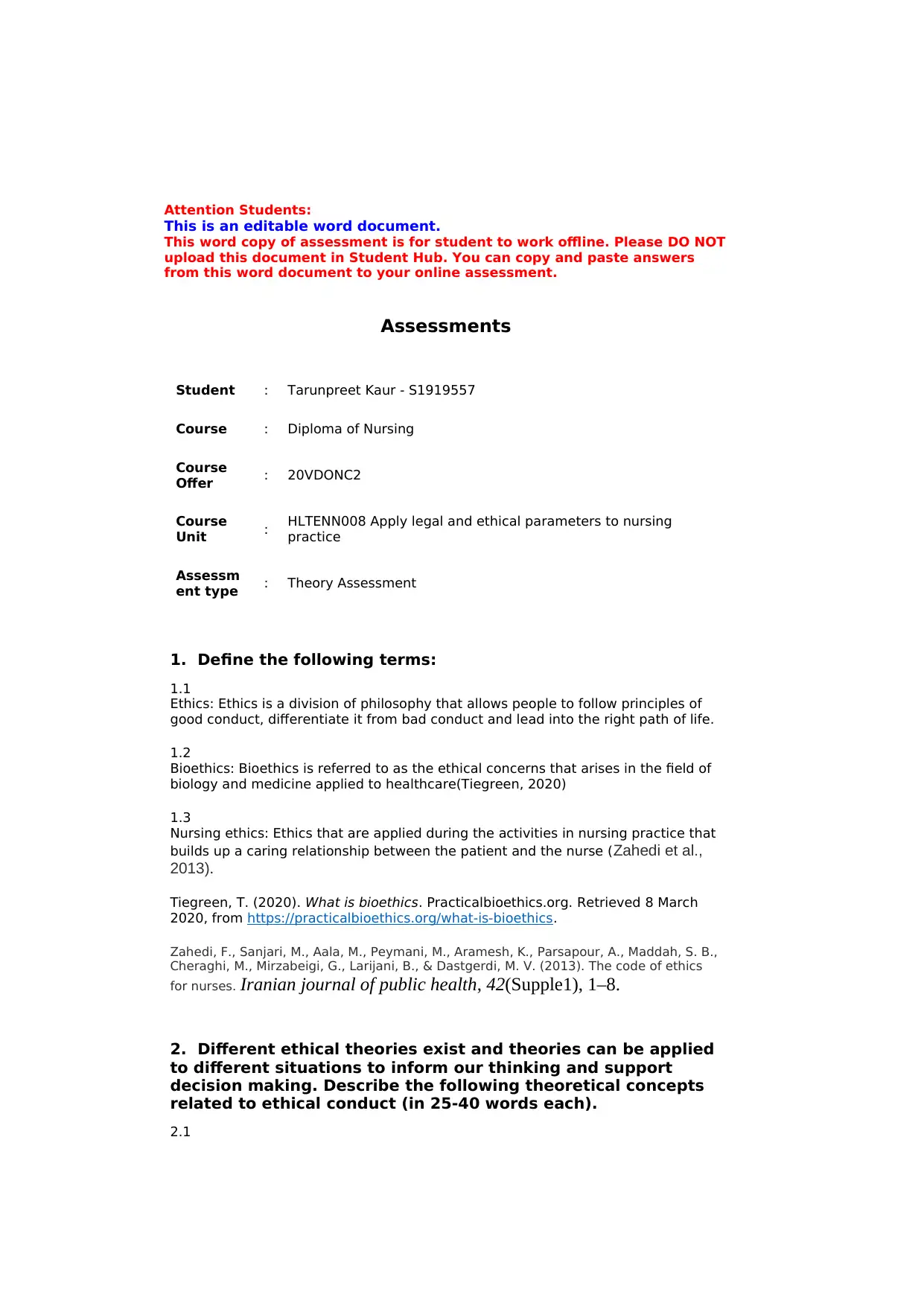
Attention Students:
This is an editable word document.
This word copy of assessment is for student to work offline. Please DO NOT
upload this document in Student Hub. You can copy and paste answers
from this word document to your online assessment.
Assessments
Student : Tarunpreet Kaur - S1919557
Course : Diploma of Nursing
Course
Offer : 20VDONC2
Course
Unit : HLTENN008 Apply legal and ethical parameters to nursing
practice
Assessm
ent type : Theory Assessment
1. Define the following terms:
1.1
Ethics: Ethics is a division of philosophy that allows people to follow principles of
good conduct, differentiate it from bad conduct and lead into the right path of life.
1.2
Bioethics: Bioethics is referred to as the ethical concerns that arises in the field of
biology and medicine applied to healthcare(Tiegreen, 2020)
1.3
Nursing ethics: Ethics that are applied during the activities in nursing practice that
builds up a caring relationship between the patient and the nurse (Zahedi et al.,
2013).
Tiegreen, T. (2020). What is bioethics. Practicalbioethics.org. Retrieved 8 March
2020, from https://practicalbioethics.org/what-is-bioethics.
Zahedi, F., Sanjari, M., Aala, M., Peymani, M., Aramesh, K., Parsapour, A., Maddah, S. B.,
Cheraghi, M., Mirzabeigi, G., Larijani, B., & Dastgerdi, M. V. (2013). The code of ethics
for nurses. Iranian journal of public health, 42(Supple1), 1–8.
2. Different ethical theories exist and theories can be applied
to different situations to inform our thinking and support
decision making. Describe the following theoretical concepts
related to ethical conduct (in 25-40 words each).
2.1
This is an editable word document.
This word copy of assessment is for student to work offline. Please DO NOT
upload this document in Student Hub. You can copy and paste answers
from this word document to your online assessment.
Assessments
Student : Tarunpreet Kaur - S1919557
Course : Diploma of Nursing
Course
Offer : 20VDONC2
Course
Unit : HLTENN008 Apply legal and ethical parameters to nursing
practice
Assessm
ent type : Theory Assessment
1. Define the following terms:
1.1
Ethics: Ethics is a division of philosophy that allows people to follow principles of
good conduct, differentiate it from bad conduct and lead into the right path of life.
1.2
Bioethics: Bioethics is referred to as the ethical concerns that arises in the field of
biology and medicine applied to healthcare(Tiegreen, 2020)
1.3
Nursing ethics: Ethics that are applied during the activities in nursing practice that
builds up a caring relationship between the patient and the nurse (Zahedi et al.,
2013).
Tiegreen, T. (2020). What is bioethics. Practicalbioethics.org. Retrieved 8 March
2020, from https://practicalbioethics.org/what-is-bioethics.
Zahedi, F., Sanjari, M., Aala, M., Peymani, M., Aramesh, K., Parsapour, A., Maddah, S. B.,
Cheraghi, M., Mirzabeigi, G., Larijani, B., & Dastgerdi, M. V. (2013). The code of ethics
for nurses. Iranian journal of public health, 42(Supple1), 1–8.
2. Different ethical theories exist and theories can be applied
to different situations to inform our thinking and support
decision making. Describe the following theoretical concepts
related to ethical conduct (in 25-40 words each).
2.1
Secure Best Marks with AI Grader
Need help grading? Try our AI Grader for instant feedback on your assignments.
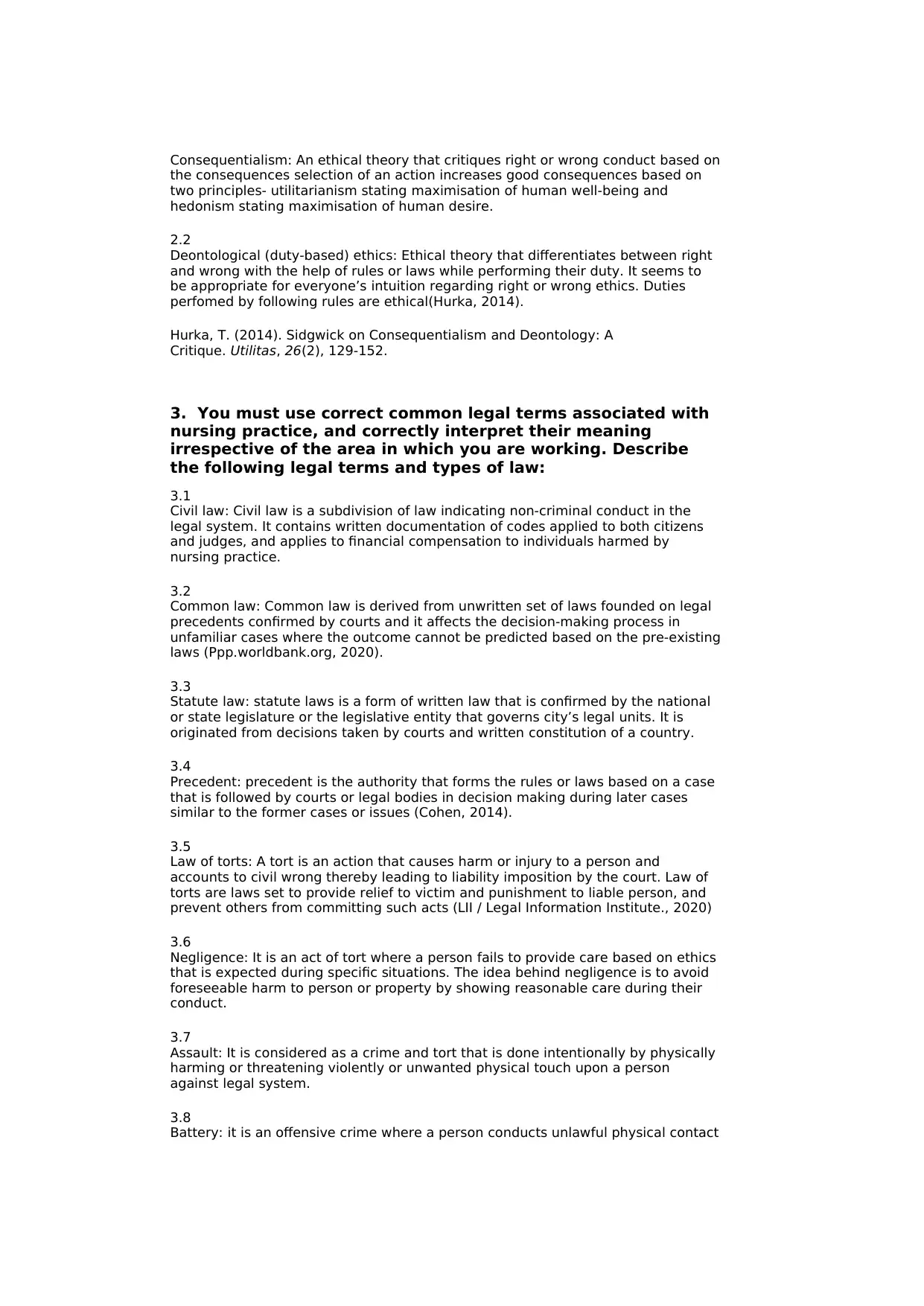
Consequentialism: An ethical theory that critiques right or wrong conduct based on
the consequences selection of an action increases good consequences based on
two principles- utilitarianism stating maximisation of human well-being and
hedonism stating maximisation of human desire.
2.2
Deontological (duty-based) ethics: Ethical theory that differentiates between right
and wrong with the help of rules or laws while performing their duty. It seems to
be appropriate for everyone’s intuition regarding right or wrong ethics. Duties
perfomed by following rules are ethical(Hurka, 2014).
Hurka, T. (2014). Sidgwick on Consequentialism and Deontology: A
Critique. Utilitas, 26(2), 129-152.
3. You must use correct common legal terms associated with
nursing practice, and correctly interpret their meaning
irrespective of the area in which you are working. Describe
the following legal terms and types of law:
3.1
Civil law: Civil law is a subdivision of law indicating non-criminal conduct in the
legal system. It contains written documentation of codes applied to both citizens
and judges, and applies to financial compensation to individuals harmed by
nursing practice.
3.2
Common law: Common law is derived from unwritten set of laws founded on legal
precedents confirmed by courts and it affects the decision-making process in
unfamiliar cases where the outcome cannot be predicted based on the pre-existing
laws (Ppp.worldbank.org, 2020).
3.3
Statute law: statute laws is a form of written law that is confirmed by the national
or state legislature or the legislative entity that governs city’s legal units. It is
originated from decisions taken by courts and written constitution of a country.
3.4
Precedent: precedent is the authority that forms the rules or laws based on a case
that is followed by courts or legal bodies in decision making during later cases
similar to the former cases or issues (Cohen, 2014).
3.5
Law of torts: A tort is an action that causes harm or injury to a person and
accounts to civil wrong thereby leading to liability imposition by the court. Law of
torts are laws set to provide relief to victim and punishment to liable person, and
prevent others from committing such acts (LII / Legal Information Institute., 2020)
3.6
Negligence: It is an act of tort where a person fails to provide care based on ethics
that is expected during specific situations. The idea behind negligence is to avoid
foreseeable harm to person or property by showing reasonable care during their
conduct.
3.7
Assault: It is considered as a crime and tort that is done intentionally by physically
harming or threatening violently or unwanted physical touch upon a person
against legal system.
3.8
Battery: it is an offensive crime where a person conducts unlawful physical contact
the consequences selection of an action increases good consequences based on
two principles- utilitarianism stating maximisation of human well-being and
hedonism stating maximisation of human desire.
2.2
Deontological (duty-based) ethics: Ethical theory that differentiates between right
and wrong with the help of rules or laws while performing their duty. It seems to
be appropriate for everyone’s intuition regarding right or wrong ethics. Duties
perfomed by following rules are ethical(Hurka, 2014).
Hurka, T. (2014). Sidgwick on Consequentialism and Deontology: A
Critique. Utilitas, 26(2), 129-152.
3. You must use correct common legal terms associated with
nursing practice, and correctly interpret their meaning
irrespective of the area in which you are working. Describe
the following legal terms and types of law:
3.1
Civil law: Civil law is a subdivision of law indicating non-criminal conduct in the
legal system. It contains written documentation of codes applied to both citizens
and judges, and applies to financial compensation to individuals harmed by
nursing practice.
3.2
Common law: Common law is derived from unwritten set of laws founded on legal
precedents confirmed by courts and it affects the decision-making process in
unfamiliar cases where the outcome cannot be predicted based on the pre-existing
laws (Ppp.worldbank.org, 2020).
3.3
Statute law: statute laws is a form of written law that is confirmed by the national
or state legislature or the legislative entity that governs city’s legal units. It is
originated from decisions taken by courts and written constitution of a country.
3.4
Precedent: precedent is the authority that forms the rules or laws based on a case
that is followed by courts or legal bodies in decision making during later cases
similar to the former cases or issues (Cohen, 2014).
3.5
Law of torts: A tort is an action that causes harm or injury to a person and
accounts to civil wrong thereby leading to liability imposition by the court. Law of
torts are laws set to provide relief to victim and punishment to liable person, and
prevent others from committing such acts (LII / Legal Information Institute., 2020)
3.6
Negligence: It is an act of tort where a person fails to provide care based on ethics
that is expected during specific situations. The idea behind negligence is to avoid
foreseeable harm to person or property by showing reasonable care during their
conduct.
3.7
Assault: It is considered as a crime and tort that is done intentionally by physically
harming or threatening violently or unwanted physical touch upon a person
against legal system.
3.8
Battery: it is an offensive crime where a person conducts unlawful physical contact
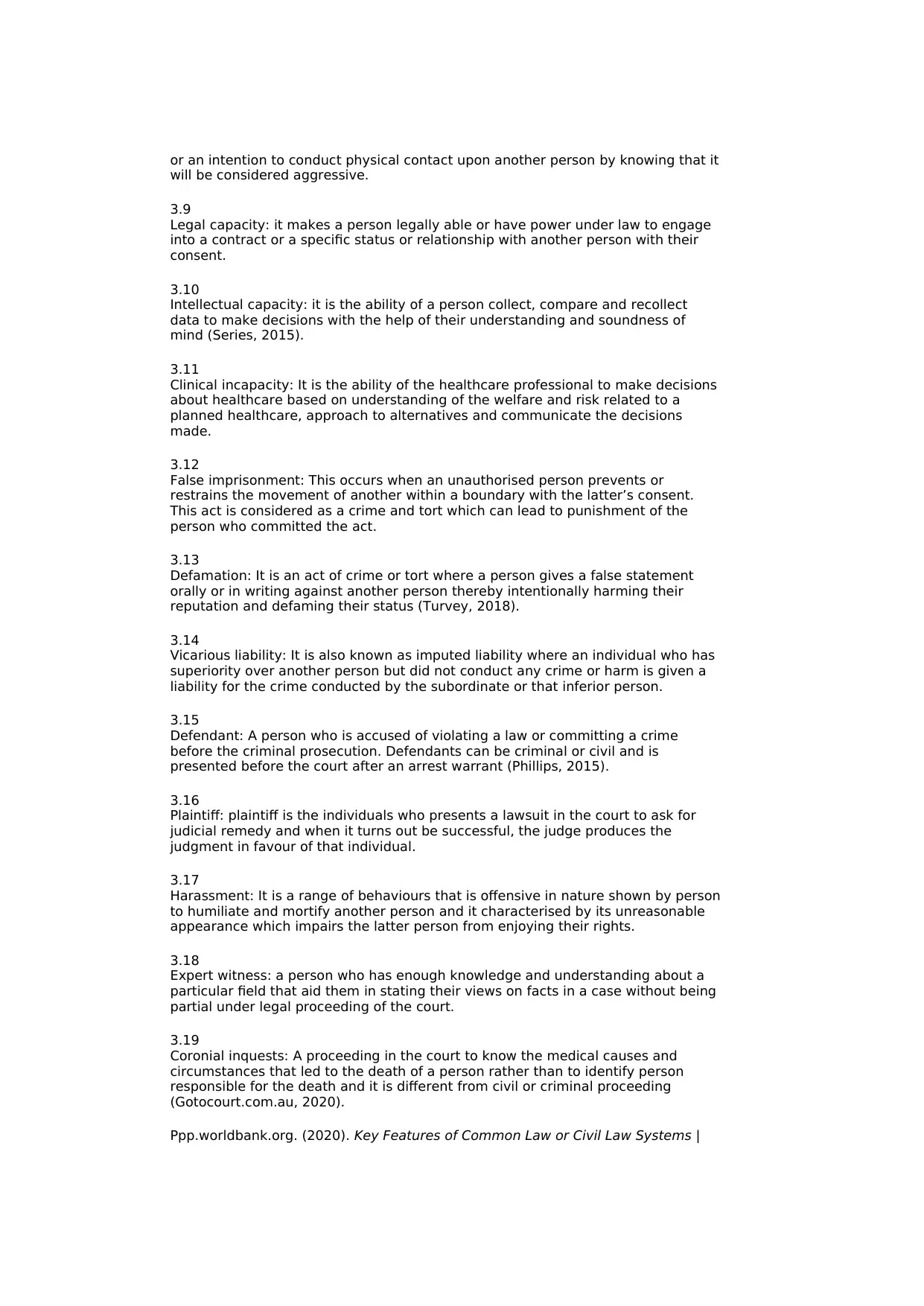
or an intention to conduct physical contact upon another person by knowing that it
will be considered aggressive.
3.9
Legal capacity: it makes a person legally able or have power under law to engage
into a contract or a specific status or relationship with another person with their
consent.
3.10
Intellectual capacity: it is the ability of a person collect, compare and recollect
data to make decisions with the help of their understanding and soundness of
mind (Series, 2015).
3.11
Clinical incapacity: It is the ability of the healthcare professional to make decisions
about healthcare based on understanding of the welfare and risk related to a
planned healthcare, approach to alternatives and communicate the decisions
made.
3.12
False imprisonment: This occurs when an unauthorised person prevents or
restrains the movement of another within a boundary with the latter’s consent.
This act is considered as a crime and tort which can lead to punishment of the
person who committed the act.
3.13
Defamation: It is an act of crime or tort where a person gives a false statement
orally or in writing against another person thereby intentionally harming their
reputation and defaming their status (Turvey, 2018).
3.14
Vicarious liability: It is also known as imputed liability where an individual who has
superiority over another person but did not conduct any crime or harm is given a
liability for the crime conducted by the subordinate or that inferior person.
3.15
Defendant: A person who is accused of violating a law or committing a crime
before the criminal prosecution. Defendants can be criminal or civil and is
presented before the court after an arrest warrant (Phillips, 2015).
3.16
Plaintiff: plaintiff is the individuals who presents a lawsuit in the court to ask for
judicial remedy and when it turns out be successful, the judge produces the
judgment in favour of that individual.
3.17
Harassment: It is a range of behaviours that is offensive in nature shown by person
to humiliate and mortify another person and it characterised by its unreasonable
appearance which impairs the latter person from enjoying their rights.
3.18
Expert witness: a person who has enough knowledge and understanding about a
particular field that aid them in stating their views on facts in a case without being
partial under legal proceeding of the court.
3.19
Coronial inquests: A proceeding in the court to know the medical causes and
circumstances that led to the death of a person rather than to identify person
responsible for the death and it is different from civil or criminal proceeding
(Gotocourt.com.au, 2020).
Ppp.worldbank.org. (2020). Key Features of Common Law or Civil Law Systems |
will be considered aggressive.
3.9
Legal capacity: it makes a person legally able or have power under law to engage
into a contract or a specific status or relationship with another person with their
consent.
3.10
Intellectual capacity: it is the ability of a person collect, compare and recollect
data to make decisions with the help of their understanding and soundness of
mind (Series, 2015).
3.11
Clinical incapacity: It is the ability of the healthcare professional to make decisions
about healthcare based on understanding of the welfare and risk related to a
planned healthcare, approach to alternatives and communicate the decisions
made.
3.12
False imprisonment: This occurs when an unauthorised person prevents or
restrains the movement of another within a boundary with the latter’s consent.
This act is considered as a crime and tort which can lead to punishment of the
person who committed the act.
3.13
Defamation: It is an act of crime or tort where a person gives a false statement
orally or in writing against another person thereby intentionally harming their
reputation and defaming their status (Turvey, 2018).
3.14
Vicarious liability: It is also known as imputed liability where an individual who has
superiority over another person but did not conduct any crime or harm is given a
liability for the crime conducted by the subordinate or that inferior person.
3.15
Defendant: A person who is accused of violating a law or committing a crime
before the criminal prosecution. Defendants can be criminal or civil and is
presented before the court after an arrest warrant (Phillips, 2015).
3.16
Plaintiff: plaintiff is the individuals who presents a lawsuit in the court to ask for
judicial remedy and when it turns out be successful, the judge produces the
judgment in favour of that individual.
3.17
Harassment: It is a range of behaviours that is offensive in nature shown by person
to humiliate and mortify another person and it characterised by its unreasonable
appearance which impairs the latter person from enjoying their rights.
3.18
Expert witness: a person who has enough knowledge and understanding about a
particular field that aid them in stating their views on facts in a case without being
partial under legal proceeding of the court.
3.19
Coronial inquests: A proceeding in the court to know the medical causes and
circumstances that led to the death of a person rather than to identify person
responsible for the death and it is different from civil or criminal proceeding
(Gotocourt.com.au, 2020).
Ppp.worldbank.org. (2020). Key Features of Common Law or Civil Law Systems |
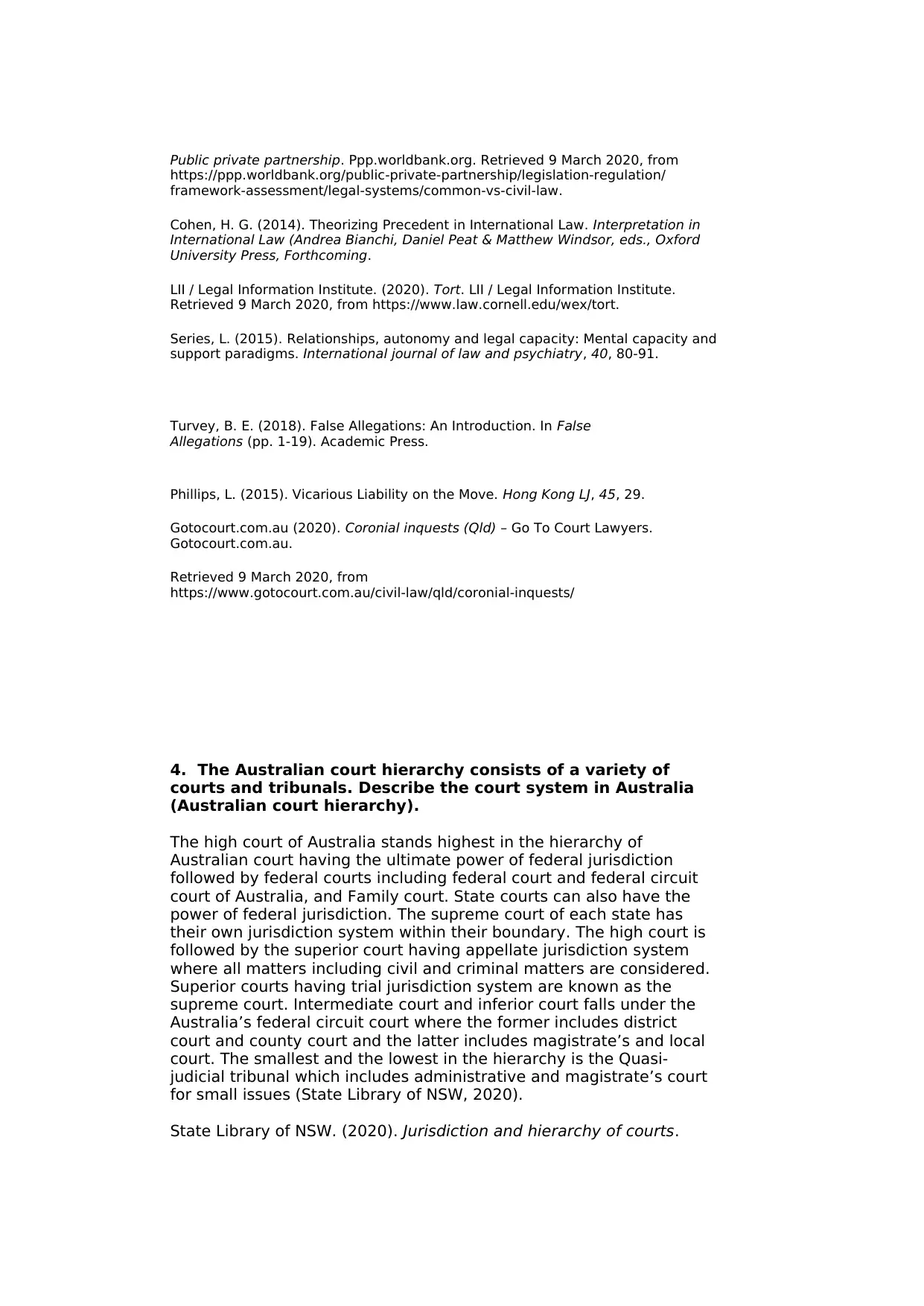
Public private partnership. Ppp.worldbank.org. Retrieved 9 March 2020, from
https://ppp.worldbank.org/public-private-partnership/legislation-regulation/
framework-assessment/legal-systems/common-vs-civil-law.
Cohen, H. G. (2014). Theorizing Precedent in International Law. Interpretation in
International Law (Andrea Bianchi, Daniel Peat & Matthew Windsor, eds., Oxford
University Press, Forthcoming.
LII / Legal Information Institute. (2020). Tort. LII / Legal Information Institute.
Retrieved 9 March 2020, from https://www.law.cornell.edu/wex/tort.
Series, L. (2015). Relationships, autonomy and legal capacity: Mental capacity and
support paradigms. International journal of law and psychiatry, 40, 80-91.
Turvey, B. E. (2018). False Allegations: An Introduction. In False
Allegations (pp. 1-19). Academic Press.
Phillips, L. (2015). Vicarious Liability on the Move. Hong Kong LJ, 45, 29.
Gotocourt.com.au (2020). Coronial inquests (Qld) – Go To Court Lawyers.
Gotocourt.com.au.
Retrieved 9 March 2020, from
https://www.gotocourt.com.au/civil-law/qld/coronial-inquests/
4. The Australian court hierarchy consists of a variety of
courts and tribunals. Describe the court system in Australia
(Australian court hierarchy).
The high court of Australia stands highest in the hierarchy of
Australian court having the ultimate power of federal jurisdiction
followed by federal courts including federal court and federal circuit
court of Australia, and Family court. State courts can also have the
power of federal jurisdiction. The supreme court of each state has
their own jurisdiction system within their boundary. The high court is
followed by the superior court having appellate jurisdiction system
where all matters including civil and criminal matters are considered.
Superior courts having trial jurisdiction system are known as the
supreme court. Intermediate court and inferior court falls under the
Australia’s federal circuit court where the former includes district
court and county court and the latter includes magistrate’s and local
court. The smallest and the lowest in the hierarchy is the Quasi-
judicial tribunal which includes administrative and magistrate’s court
for small issues (State Library of NSW, 2020).
State Library of NSW. (2020). Jurisdiction and hierarchy of courts.
https://ppp.worldbank.org/public-private-partnership/legislation-regulation/
framework-assessment/legal-systems/common-vs-civil-law.
Cohen, H. G. (2014). Theorizing Precedent in International Law. Interpretation in
International Law (Andrea Bianchi, Daniel Peat & Matthew Windsor, eds., Oxford
University Press, Forthcoming.
LII / Legal Information Institute. (2020). Tort. LII / Legal Information Institute.
Retrieved 9 March 2020, from https://www.law.cornell.edu/wex/tort.
Series, L. (2015). Relationships, autonomy and legal capacity: Mental capacity and
support paradigms. International journal of law and psychiatry, 40, 80-91.
Turvey, B. E. (2018). False Allegations: An Introduction. In False
Allegations (pp. 1-19). Academic Press.
Phillips, L. (2015). Vicarious Liability on the Move. Hong Kong LJ, 45, 29.
Gotocourt.com.au (2020). Coronial inquests (Qld) – Go To Court Lawyers.
Gotocourt.com.au.
Retrieved 9 March 2020, from
https://www.gotocourt.com.au/civil-law/qld/coronial-inquests/
4. The Australian court hierarchy consists of a variety of
courts and tribunals. Describe the court system in Australia
(Australian court hierarchy).
The high court of Australia stands highest in the hierarchy of
Australian court having the ultimate power of federal jurisdiction
followed by federal courts including federal court and federal circuit
court of Australia, and Family court. State courts can also have the
power of federal jurisdiction. The supreme court of each state has
their own jurisdiction system within their boundary. The high court is
followed by the superior court having appellate jurisdiction system
where all matters including civil and criminal matters are considered.
Superior courts having trial jurisdiction system are known as the
supreme court. Intermediate court and inferior court falls under the
Australia’s federal circuit court where the former includes district
court and county court and the latter includes magistrate’s and local
court. The smallest and the lowest in the hierarchy is the Quasi-
judicial tribunal which includes administrative and magistrate’s court
for small issues (State Library of NSW, 2020).
State Library of NSW. (2020). Jurisdiction and hierarchy of courts.
Secure Best Marks with AI Grader
Need help grading? Try our AI Grader for instant feedback on your assignments.
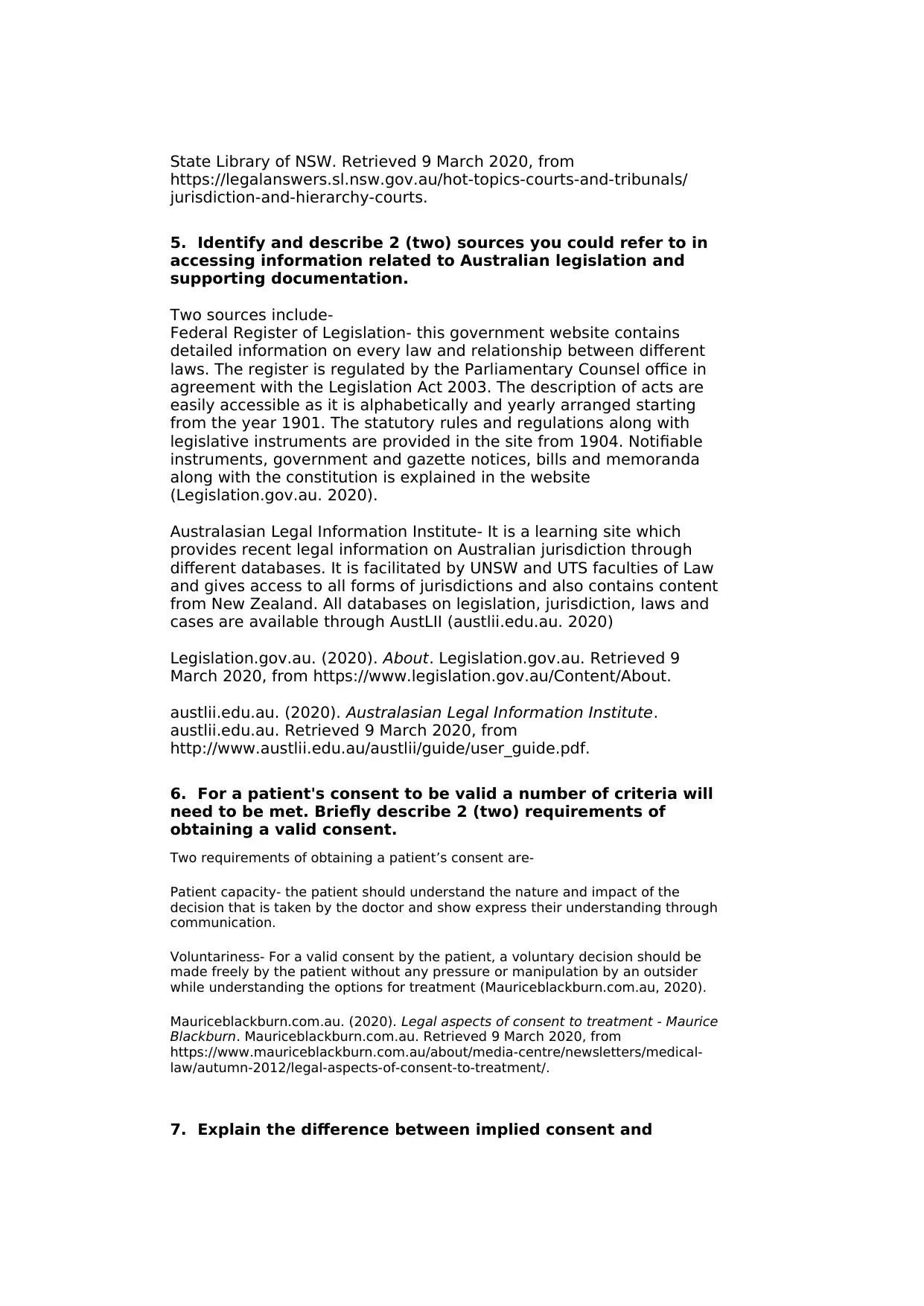
State Library of NSW. Retrieved 9 March 2020, from
https://legalanswers.sl.nsw.gov.au/hot-topics-courts-and-tribunals/
jurisdiction-and-hierarchy-courts.
5. Identify and describe 2 (two) sources you could refer to in
accessing information related to Australian legislation and
supporting documentation.
Two sources include-
Federal Register of Legislation- this government website contains
detailed information on every law and relationship between different
laws. The register is regulated by the Parliamentary Counsel office in
agreement with the Legislation Act 2003. The description of acts are
easily accessible as it is alphabetically and yearly arranged starting
from the year 1901. The statutory rules and regulations along with
legislative instruments are provided in the site from 1904. Notifiable
instruments, government and gazette notices, bills and memoranda
along with the constitution is explained in the website
(Legislation.gov.au. 2020).
Australasian Legal Information Institute- It is a learning site which
provides recent legal information on Australian jurisdiction through
different databases. It is facilitated by UNSW and UTS faculties of Law
and gives access to all forms of jurisdictions and also contains content
from New Zealand. All databases on legislation, jurisdiction, laws and
cases are available through AustLII (austlii.edu.au. 2020)
Legislation.gov.au. (2020). About. Legislation.gov.au. Retrieved 9
March 2020, from https://www.legislation.gov.au/Content/About.
austlii.edu.au. (2020). Australasian Legal Information Institute.
austlii.edu.au. Retrieved 9 March 2020, from
http://www.austlii.edu.au/austlii/guide/user_guide.pdf.
6. For a patient's consent to be valid a number of criteria will
need to be met. Briefly describe 2 (two) requirements of
obtaining a valid consent.
Two requirements of obtaining a patient’s consent are-
Patient capacity- the patient should understand the nature and impact of the
decision that is taken by the doctor and show express their understanding through
communication.
Voluntariness- For a valid consent by the patient, a voluntary decision should be
made freely by the patient without any pressure or manipulation by an outsider
while understanding the options for treatment (Mauriceblackburn.com.au, 2020).
Mauriceblackburn.com.au. (2020). Legal aspects of consent to treatment - Maurice
Blackburn. Mauriceblackburn.com.au. Retrieved 9 March 2020, from
https://www.mauriceblackburn.com.au/about/media-centre/newsletters/medical-
law/autumn-2012/legal-aspects-of-consent-to-treatment/.
7. Explain the difference between implied consent and
https://legalanswers.sl.nsw.gov.au/hot-topics-courts-and-tribunals/
jurisdiction-and-hierarchy-courts.
5. Identify and describe 2 (two) sources you could refer to in
accessing information related to Australian legislation and
supporting documentation.
Two sources include-
Federal Register of Legislation- this government website contains
detailed information on every law and relationship between different
laws. The register is regulated by the Parliamentary Counsel office in
agreement with the Legislation Act 2003. The description of acts are
easily accessible as it is alphabetically and yearly arranged starting
from the year 1901. The statutory rules and regulations along with
legislative instruments are provided in the site from 1904. Notifiable
instruments, government and gazette notices, bills and memoranda
along with the constitution is explained in the website
(Legislation.gov.au. 2020).
Australasian Legal Information Institute- It is a learning site which
provides recent legal information on Australian jurisdiction through
different databases. It is facilitated by UNSW and UTS faculties of Law
and gives access to all forms of jurisdictions and also contains content
from New Zealand. All databases on legislation, jurisdiction, laws and
cases are available through AustLII (austlii.edu.au. 2020)
Legislation.gov.au. (2020). About. Legislation.gov.au. Retrieved 9
March 2020, from https://www.legislation.gov.au/Content/About.
austlii.edu.au. (2020). Australasian Legal Information Institute.
austlii.edu.au. Retrieved 9 March 2020, from
http://www.austlii.edu.au/austlii/guide/user_guide.pdf.
6. For a patient's consent to be valid a number of criteria will
need to be met. Briefly describe 2 (two) requirements of
obtaining a valid consent.
Two requirements of obtaining a patient’s consent are-
Patient capacity- the patient should understand the nature and impact of the
decision that is taken by the doctor and show express their understanding through
communication.
Voluntariness- For a valid consent by the patient, a voluntary decision should be
made freely by the patient without any pressure or manipulation by an outsider
while understanding the options for treatment (Mauriceblackburn.com.au, 2020).
Mauriceblackburn.com.au. (2020). Legal aspects of consent to treatment - Maurice
Blackburn. Mauriceblackburn.com.au. Retrieved 9 March 2020, from
https://www.mauriceblackburn.com.au/about/media-centre/newsletters/medical-
law/autumn-2012/legal-aspects-of-consent-to-treatment/.
7. Explain the difference between implied consent and
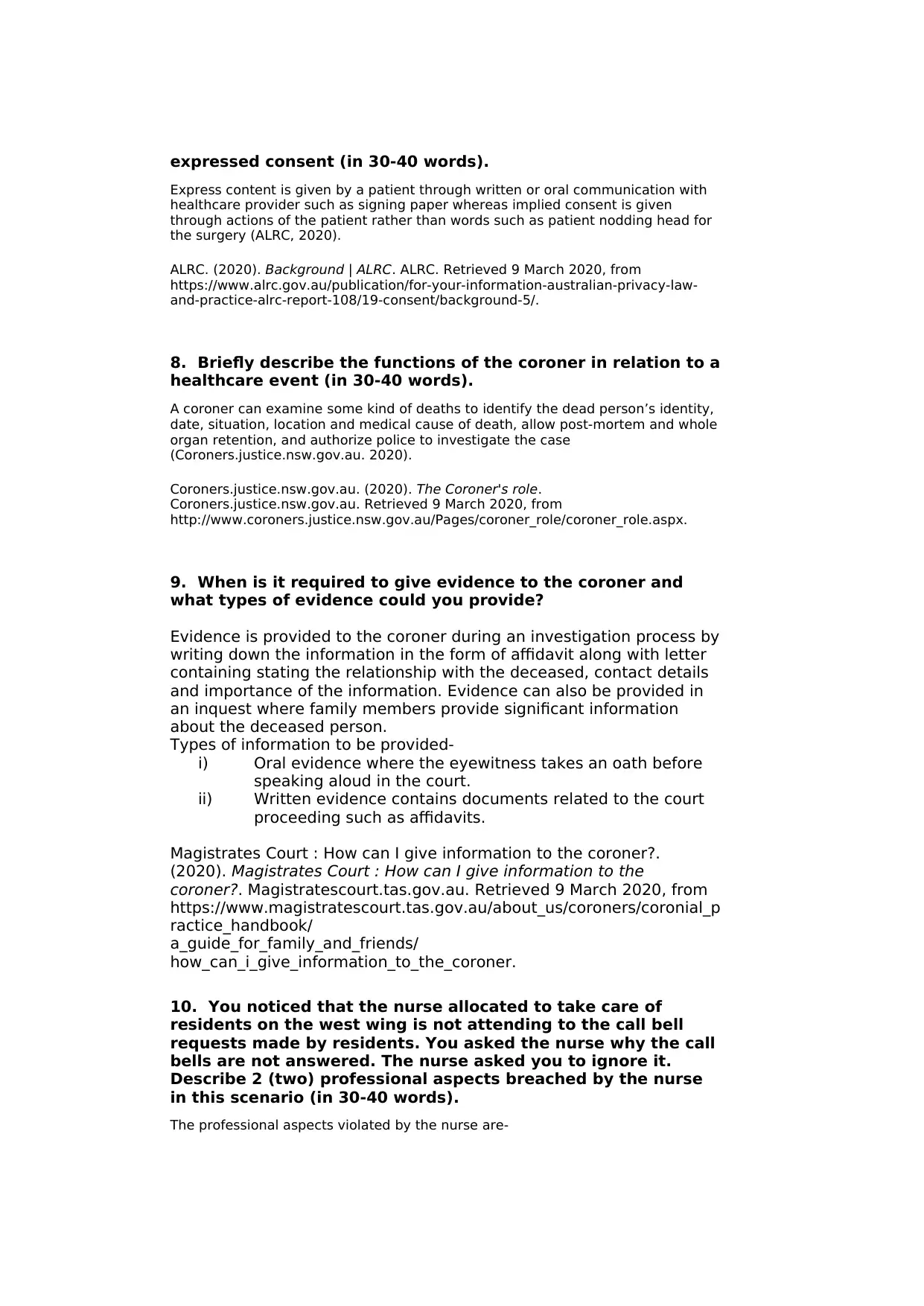
expressed consent (in 30-40 words).
Express content is given by a patient through written or oral communication with
healthcare provider such as signing paper whereas implied consent is given
through actions of the patient rather than words such as patient nodding head for
the surgery (ALRC, 2020).
ALRC. (2020). Background | ALRC. ALRC. Retrieved 9 March 2020, from
https://www.alrc.gov.au/publication/for-your-information-australian-privacy-law-
and-practice-alrc-report-108/19-consent/background-5/.
8. Briefly describe the functions of the coroner in relation to a
healthcare event (in 30-40 words).
A coroner can examine some kind of deaths to identify the dead person’s identity,
date, situation, location and medical cause of death, allow post-mortem and whole
organ retention, and authorize police to investigate the case
(Coroners.justice.nsw.gov.au. 2020).
Coroners.justice.nsw.gov.au. (2020). The Coroner's role.
Coroners.justice.nsw.gov.au. Retrieved 9 March 2020, from
http://www.coroners.justice.nsw.gov.au/Pages/coroner_role/coroner_role.aspx.
9. When is it required to give evidence to the coroner and
what types of evidence could you provide?
Evidence is provided to the coroner during an investigation process by
writing down the information in the form of affidavit along with letter
containing stating the relationship with the deceased, contact details
and importance of the information. Evidence can also be provided in
an inquest where family members provide significant information
about the deceased person.
Types of information to be provided-
i) Oral evidence where the eyewitness takes an oath before
speaking aloud in the court.
ii) Written evidence contains documents related to the court
proceeding such as affidavits.
Magistrates Court : How can I give information to the coroner?.
(2020). Magistrates Court : How can I give information to the
coroner?. Magistratescourt.tas.gov.au. Retrieved 9 March 2020, from
https://www.magistratescourt.tas.gov.au/about_us/coroners/coronial_p
ractice_handbook/
a_guide_for_family_and_friends/
how_can_i_give_information_to_the_coroner.
10. You noticed that the nurse allocated to take care of
residents on the west wing is not attending to the call bell
requests made by residents. You asked the nurse why the call
bells are not answered. The nurse asked you to ignore it.
Describe 2 (two) professional aspects breached by the nurse
in this scenario (in 30-40 words).
The professional aspects violated by the nurse are-
Express content is given by a patient through written or oral communication with
healthcare provider such as signing paper whereas implied consent is given
through actions of the patient rather than words such as patient nodding head for
the surgery (ALRC, 2020).
ALRC. (2020). Background | ALRC. ALRC. Retrieved 9 March 2020, from
https://www.alrc.gov.au/publication/for-your-information-australian-privacy-law-
and-practice-alrc-report-108/19-consent/background-5/.
8. Briefly describe the functions of the coroner in relation to a
healthcare event (in 30-40 words).
A coroner can examine some kind of deaths to identify the dead person’s identity,
date, situation, location and medical cause of death, allow post-mortem and whole
organ retention, and authorize police to investigate the case
(Coroners.justice.nsw.gov.au. 2020).
Coroners.justice.nsw.gov.au. (2020). The Coroner's role.
Coroners.justice.nsw.gov.au. Retrieved 9 March 2020, from
http://www.coroners.justice.nsw.gov.au/Pages/coroner_role/coroner_role.aspx.
9. When is it required to give evidence to the coroner and
what types of evidence could you provide?
Evidence is provided to the coroner during an investigation process by
writing down the information in the form of affidavit along with letter
containing stating the relationship with the deceased, contact details
and importance of the information. Evidence can also be provided in
an inquest where family members provide significant information
about the deceased person.
Types of information to be provided-
i) Oral evidence where the eyewitness takes an oath before
speaking aloud in the court.
ii) Written evidence contains documents related to the court
proceeding such as affidavits.
Magistrates Court : How can I give information to the coroner?.
(2020). Magistrates Court : How can I give information to the
coroner?. Magistratescourt.tas.gov.au. Retrieved 9 March 2020, from
https://www.magistratescourt.tas.gov.au/about_us/coroners/coronial_p
ractice_handbook/
a_guide_for_family_and_friends/
how_can_i_give_information_to_the_coroner.
10. You noticed that the nurse allocated to take care of
residents on the west wing is not attending to the call bell
requests made by residents. You asked the nurse why the call
bells are not answered. The nurse asked you to ignore it.
Describe 2 (two) professional aspects breached by the nurse
in this scenario (in 30-40 words).
The professional aspects violated by the nurse are-

Altruism is not followed where patients are neglected because the nurse was not
attending the patients request.
Accountability in nursing practice is violated because the nurse was not taking
responsibility of her actions and decisions related to patient care (Ghadirian,
Salsali & Cheraghi, 2014)
Ghadirian, F., Salsali, M., & Cheraghi, M. A. (2014). Nursing professionalism: An
evolutionary concept analysis. Iranian journal of nursing and midwifery
research, 19(1), 1–10.
11. The registered nurse asked a student nurse to assist a
resident with shaving. The student nurse is asked to perform
the task without anyone supervising her. Applying the
concept of vicarious liability, explain who will be held
responsible for the actions or omissions of the student nurse?
Will that be the student nurse herself or the registered nurse?
(in 30-40 words).
In accordance with vicarious liability for any mistake done by the
student nurse during her task, registered nurse will be held
responsible for the causing harm even if it was not their fault because
registered nurse was superior to student nurse.
12. You are asked by the registered nurse to provide oral
care to a resident. When should you obtain consent from the
resident to proceed with the care? (in 20-30 words).
Once the resident has understood the decision about the treatment to be provided
for her oral problems and when she has accepted the decision, I will take her
informed consent.
13. Identify and outline 2 (two) legal requirements you must
apply when writing nursing reports.
Two legal requirements that I will follow while writing nursing reports are-
i) Common law which indicates that patient have the right to obtain
information about their medical state, consent on the treatment and
risks associated with it along with possible outcomes.
ii) Torts that addresses my responsibility as a nurse towards my patient
and avoiding misconduct in nursing practice such as negligence,
violation and malpractice associated with patient confidentiality.
14. Whom would you seek clarification from for concerns
relating to requests for tests and referrals for your residents
in the workplace? Identify 2 (two) personnel who could assist
you.
For assisting me during conducting tests and referrals for residents, I would need
the help of a registered nurse and specialist. A registered would guide me with the
attending the patients request.
Accountability in nursing practice is violated because the nurse was not taking
responsibility of her actions and decisions related to patient care (Ghadirian,
Salsali & Cheraghi, 2014)
Ghadirian, F., Salsali, M., & Cheraghi, M. A. (2014). Nursing professionalism: An
evolutionary concept analysis. Iranian journal of nursing and midwifery
research, 19(1), 1–10.
11. The registered nurse asked a student nurse to assist a
resident with shaving. The student nurse is asked to perform
the task without anyone supervising her. Applying the
concept of vicarious liability, explain who will be held
responsible for the actions or omissions of the student nurse?
Will that be the student nurse herself or the registered nurse?
(in 30-40 words).
In accordance with vicarious liability for any mistake done by the
student nurse during her task, registered nurse will be held
responsible for the causing harm even if it was not their fault because
registered nurse was superior to student nurse.
12. You are asked by the registered nurse to provide oral
care to a resident. When should you obtain consent from the
resident to proceed with the care? (in 20-30 words).
Once the resident has understood the decision about the treatment to be provided
for her oral problems and when she has accepted the decision, I will take her
informed consent.
13. Identify and outline 2 (two) legal requirements you must
apply when writing nursing reports.
Two legal requirements that I will follow while writing nursing reports are-
i) Common law which indicates that patient have the right to obtain
information about their medical state, consent on the treatment and
risks associated with it along with possible outcomes.
ii) Torts that addresses my responsibility as a nurse towards my patient
and avoiding misconduct in nursing practice such as negligence,
violation and malpractice associated with patient confidentiality.
14. Whom would you seek clarification from for concerns
relating to requests for tests and referrals for your residents
in the workplace? Identify 2 (two) personnel who could assist
you.
For assisting me during conducting tests and referrals for residents, I would need
the help of a registered nurse and specialist. A registered would guide me with the
Paraphrase This Document
Need a fresh take? Get an instant paraphrase of this document with our AI Paraphraser

issues concerning the residents and the specialist would identify the type of tests
and referrals to be performed after assessing the medical condition of the
resisdents.
15. With reference to, there are different legal and ethical
considerations underpinning nursing practice and this may
vary between States and Territories. Various legal and ethical
considerations relevant to the nursing profession are
identified below. Explain how these are applied in nursing
practice in your State/Territory (in 40-50 words each).
Contemporary ethical concepts and principles in nursing:
15.1
Autonomy: It is the right given to the patient in making decisions. The nurse may
advise the patient with the help of their professional knowledge in deciding the
course of action. Before deciding effectively the patient must be informed about
the consequences of the course of action and provided with alternatives.
15.2
Beneficence: The concept is to promote good health of the patient through actions
taken by the nurse. The nurse should identify the best course of action for the
patient even if it means death of the patient. For this the nurse should understand
the needs of the patient.
15.3
Non-maleficence: The concept is to consider doing unintentional and harmless
care to the patient to reach an effective outcome. Nurses should provide standard
care which include avoiding risk related to patient care and this can be done by
not neglecting the patient (Heale & Shorten, 2017).
15.4
Justice: Nurses should follow fair means of providing patient care and treat every
patient equally. While making decisions for a group of patients, she should be
impartial towards any patient in that group even if there are limited resources for
treatment or patients differ in their ethnicity and economic status.
15.5
Rights: Nurses have the right to practice nursing in order to complete obligations
to the society and individuals receiving care. To act effectively according to the
professional standards and authorized choice of practice, they should be provide
with the right to practice to gain knowledge and skills regarding nursing care.
15.6
Veracity: Veracity is the related to the principle of autonomy where the healthcare
provider should be honest while telling facts about the medical condition of the
patients and informing truthfully about related treatments. It aids in building trust
between the patient and the healthcare provider while establishing shared
treatment goals.
Heale, R., & Shorten, A. (2017). Ethical context of nursing research. Evidence-
based nursing, 20(1), 7-7.
16. Various pieces of legislation are enacted in each
State/Territory underpinning nursing practice. Identify the
legislation relevant to your State/Territory relating to the
and referrals to be performed after assessing the medical condition of the
resisdents.
15. With reference to, there are different legal and ethical
considerations underpinning nursing practice and this may
vary between States and Territories. Various legal and ethical
considerations relevant to the nursing profession are
identified below. Explain how these are applied in nursing
practice in your State/Territory (in 40-50 words each).
Contemporary ethical concepts and principles in nursing:
15.1
Autonomy: It is the right given to the patient in making decisions. The nurse may
advise the patient with the help of their professional knowledge in deciding the
course of action. Before deciding effectively the patient must be informed about
the consequences of the course of action and provided with alternatives.
15.2
Beneficence: The concept is to promote good health of the patient through actions
taken by the nurse. The nurse should identify the best course of action for the
patient even if it means death of the patient. For this the nurse should understand
the needs of the patient.
15.3
Non-maleficence: The concept is to consider doing unintentional and harmless
care to the patient to reach an effective outcome. Nurses should provide standard
care which include avoiding risk related to patient care and this can be done by
not neglecting the patient (Heale & Shorten, 2017).
15.4
Justice: Nurses should follow fair means of providing patient care and treat every
patient equally. While making decisions for a group of patients, she should be
impartial towards any patient in that group even if there are limited resources for
treatment or patients differ in their ethnicity and economic status.
15.5
Rights: Nurses have the right to practice nursing in order to complete obligations
to the society and individuals receiving care. To act effectively according to the
professional standards and authorized choice of practice, they should be provide
with the right to practice to gain knowledge and skills regarding nursing care.
15.6
Veracity: Veracity is the related to the principle of autonomy where the healthcare
provider should be honest while telling facts about the medical condition of the
patients and informing truthfully about related treatments. It aids in building trust
between the patient and the healthcare provider while establishing shared
treatment goals.
Heale, R., & Shorten, A. (2017). Ethical context of nursing research. Evidence-
based nursing, 20(1), 7-7.
16. Various pieces of legislation are enacted in each
State/Territory underpinning nursing practice. Identify the
legislation relevant to your State/Territory relating to the
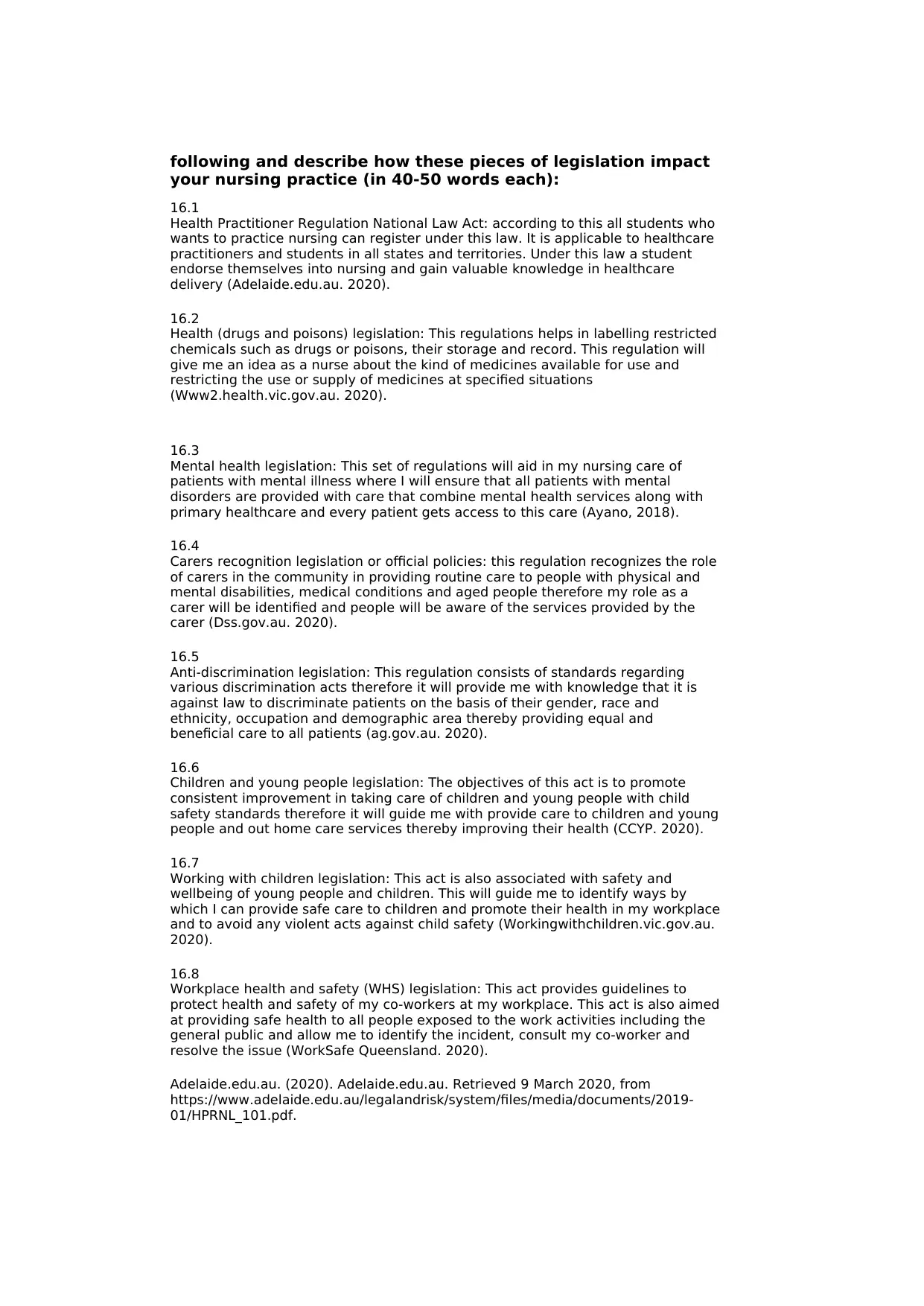
following and describe how these pieces of legislation impact
your nursing practice (in 40-50 words each):
16.1
Health Practitioner Regulation National Law Act: according to this all students who
wants to practice nursing can register under this law. It is applicable to healthcare
practitioners and students in all states and territories. Under this law a student
endorse themselves into nursing and gain valuable knowledge in healthcare
delivery (Adelaide.edu.au. 2020).
16.2
Health (drugs and poisons) legislation: This regulations helps in labelling restricted
chemicals such as drugs or poisons, their storage and record. This regulation will
give me an idea as a nurse about the kind of medicines available for use and
restricting the use or supply of medicines at specified situations
(Www2.health.vic.gov.au. 2020).
16.3
Mental health legislation: This set of regulations will aid in my nursing care of
patients with mental illness where I will ensure that all patients with mental
disorders are provided with care that combine mental health services along with
primary healthcare and every patient gets access to this care (Ayano, 2018).
16.4
Carers recognition legislation or official policies: this regulation recognizes the role
of carers in the community in providing routine care to people with physical and
mental disabilities, medical conditions and aged people therefore my role as a
carer will be identified and people will be aware of the services provided by the
carer (Dss.gov.au. 2020).
16.5
Anti-discrimination legislation: This regulation consists of standards regarding
various discrimination acts therefore it will provide me with knowledge that it is
against law to discriminate patients on the basis of their gender, race and
ethnicity, occupation and demographic area thereby providing equal and
beneficial care to all patients (ag.gov.au. 2020).
16.6
Children and young people legislation: The objectives of this act is to promote
consistent improvement in taking care of children and young people with child
safety standards therefore it will guide me with provide care to children and young
people and out home care services thereby improving their health (CCYP. 2020).
16.7
Working with children legislation: This act is also associated with safety and
wellbeing of young people and children. This will guide me to identify ways by
which I can provide safe care to children and promote their health in my workplace
and to avoid any violent acts against child safety (Workingwithchildren.vic.gov.au.
2020).
16.8
Workplace health and safety (WHS) legislation: This act provides guidelines to
protect health and safety of my co-workers at my workplace. This act is also aimed
at providing safe health to all people exposed to the work activities including the
general public and allow me to identify the incident, consult my co-worker and
resolve the issue (WorkSafe Queensland. 2020).
Adelaide.edu.au. (2020). Adelaide.edu.au. Retrieved 9 March 2020, from
https://www.adelaide.edu.au/legalandrisk/system/files/media/documents/2019-
01/HPRNL_101.pdf.
your nursing practice (in 40-50 words each):
16.1
Health Practitioner Regulation National Law Act: according to this all students who
wants to practice nursing can register under this law. It is applicable to healthcare
practitioners and students in all states and territories. Under this law a student
endorse themselves into nursing and gain valuable knowledge in healthcare
delivery (Adelaide.edu.au. 2020).
16.2
Health (drugs and poisons) legislation: This regulations helps in labelling restricted
chemicals such as drugs or poisons, their storage and record. This regulation will
give me an idea as a nurse about the kind of medicines available for use and
restricting the use or supply of medicines at specified situations
(Www2.health.vic.gov.au. 2020).
16.3
Mental health legislation: This set of regulations will aid in my nursing care of
patients with mental illness where I will ensure that all patients with mental
disorders are provided with care that combine mental health services along with
primary healthcare and every patient gets access to this care (Ayano, 2018).
16.4
Carers recognition legislation or official policies: this regulation recognizes the role
of carers in the community in providing routine care to people with physical and
mental disabilities, medical conditions and aged people therefore my role as a
carer will be identified and people will be aware of the services provided by the
carer (Dss.gov.au. 2020).
16.5
Anti-discrimination legislation: This regulation consists of standards regarding
various discrimination acts therefore it will provide me with knowledge that it is
against law to discriminate patients on the basis of their gender, race and
ethnicity, occupation and demographic area thereby providing equal and
beneficial care to all patients (ag.gov.au. 2020).
16.6
Children and young people legislation: The objectives of this act is to promote
consistent improvement in taking care of children and young people with child
safety standards therefore it will guide me with provide care to children and young
people and out home care services thereby improving their health (CCYP. 2020).
16.7
Working with children legislation: This act is also associated with safety and
wellbeing of young people and children. This will guide me to identify ways by
which I can provide safe care to children and promote their health in my workplace
and to avoid any violent acts against child safety (Workingwithchildren.vic.gov.au.
2020).
16.8
Workplace health and safety (WHS) legislation: This act provides guidelines to
protect health and safety of my co-workers at my workplace. This act is also aimed
at providing safe health to all people exposed to the work activities including the
general public and allow me to identify the incident, consult my co-worker and
resolve the issue (WorkSafe Queensland. 2020).
Adelaide.edu.au. (2020). Adelaide.edu.au. Retrieved 9 March 2020, from
https://www.adelaide.edu.au/legalandrisk/system/files/media/documents/2019-
01/HPRNL_101.pdf.
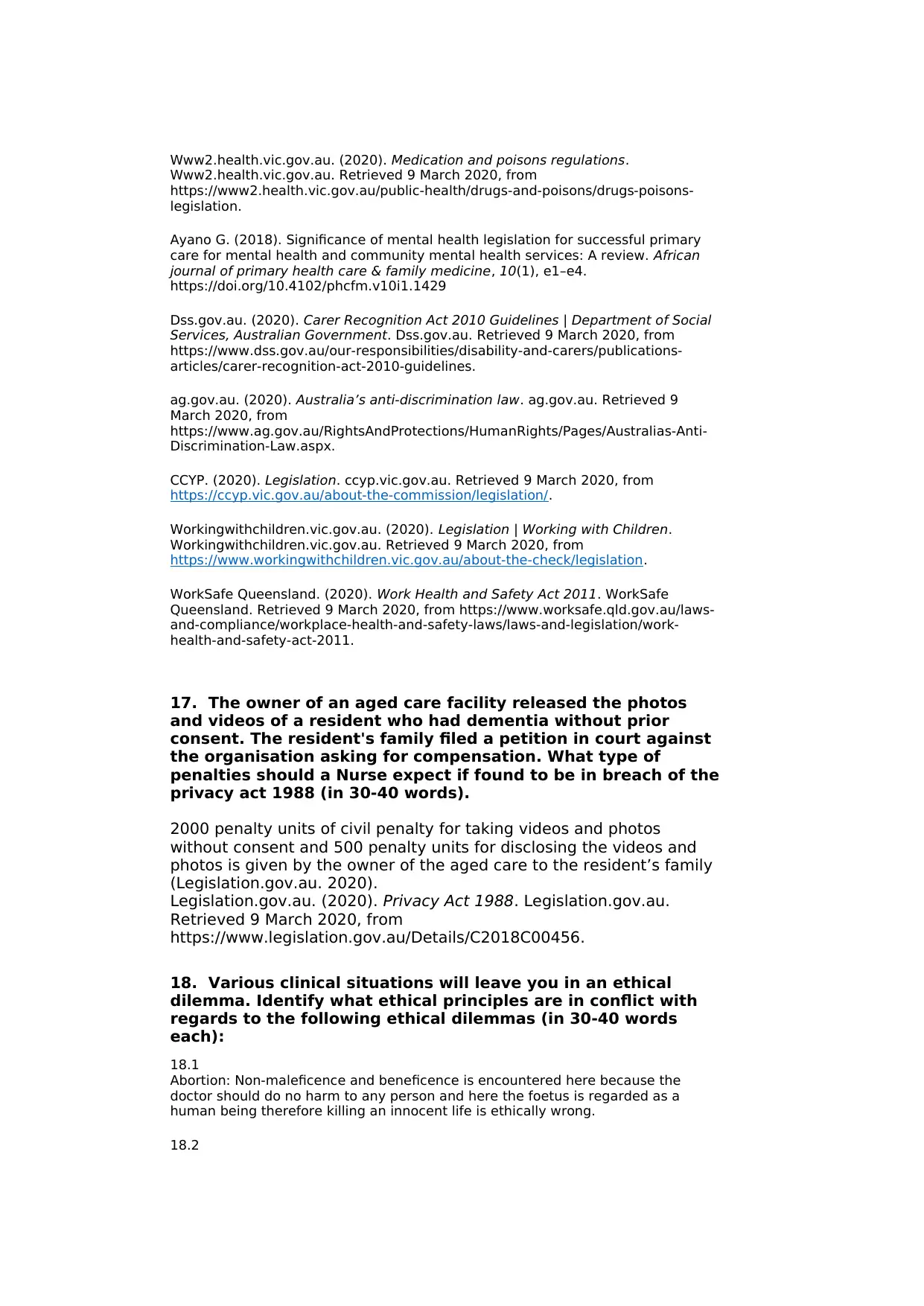
Www2.health.vic.gov.au. (2020). Medication and poisons regulations.
Www2.health.vic.gov.au. Retrieved 9 March 2020, from
https://www2.health.vic.gov.au/public-health/drugs-and-poisons/drugs-poisons-
legislation.
Ayano G. (2018). Significance of mental health legislation for successful primary
care for mental health and community mental health services: A review. African
journal of primary health care & family medicine, 10(1), e1–e4.
https://doi.org/10.4102/phcfm.v10i1.1429
Dss.gov.au. (2020). Carer Recognition Act 2010 Guidelines | Department of Social
Services, Australian Government. Dss.gov.au. Retrieved 9 March 2020, from
https://www.dss.gov.au/our-responsibilities/disability-and-carers/publications-
articles/carer-recognition-act-2010-guidelines.
ag.gov.au. (2020). Australia’s anti-discrimination law. ag.gov.au. Retrieved 9
March 2020, from
https://www.ag.gov.au/RightsAndProtections/HumanRights/Pages/Australias-Anti-
Discrimination-Law.aspx.
CCYP. (2020). Legislation. ccyp.vic.gov.au. Retrieved 9 March 2020, from
https://ccyp.vic.gov.au/about-the-commission/legislation/.
Workingwithchildren.vic.gov.au. (2020). Legislation | Working with Children.
Workingwithchildren.vic.gov.au. Retrieved 9 March 2020, from
https://www.workingwithchildren.vic.gov.au/about-the-check/legislation.
WorkSafe Queensland. (2020). Work Health and Safety Act 2011. WorkSafe
Queensland. Retrieved 9 March 2020, from https://www.worksafe.qld.gov.au/laws-
and-compliance/workplace-health-and-safety-laws/laws-and-legislation/work-
health-and-safety-act-2011.
17. The owner of an aged care facility released the photos
and videos of a resident who had dementia without prior
consent. The resident's family filed a petition in court against
the organisation asking for compensation. What type of
penalties should a Nurse expect if found to be in breach of the
privacy act 1988 (in 30-40 words).
2000 penalty units of civil penalty for taking videos and photos
without consent and 500 penalty units for disclosing the videos and
photos is given by the owner of the aged care to the resident’s family
(Legislation.gov.au. 2020).
Legislation.gov.au. (2020). Privacy Act 1988. Legislation.gov.au.
Retrieved 9 March 2020, from
https://www.legislation.gov.au/Details/C2018C00456.
18. Various clinical situations will leave you in an ethical
dilemma. Identify what ethical principles are in conflict with
regards to the following ethical dilemmas (in 30-40 words
each):
18.1
Abortion: Non-maleficence and beneficence is encountered here because the
doctor should do no harm to any person and here the foetus is regarded as a
human being therefore killing an innocent life is ethically wrong.
18.2
Www2.health.vic.gov.au. Retrieved 9 March 2020, from
https://www2.health.vic.gov.au/public-health/drugs-and-poisons/drugs-poisons-
legislation.
Ayano G. (2018). Significance of mental health legislation for successful primary
care for mental health and community mental health services: A review. African
journal of primary health care & family medicine, 10(1), e1–e4.
https://doi.org/10.4102/phcfm.v10i1.1429
Dss.gov.au. (2020). Carer Recognition Act 2010 Guidelines | Department of Social
Services, Australian Government. Dss.gov.au. Retrieved 9 March 2020, from
https://www.dss.gov.au/our-responsibilities/disability-and-carers/publications-
articles/carer-recognition-act-2010-guidelines.
ag.gov.au. (2020). Australia’s anti-discrimination law. ag.gov.au. Retrieved 9
March 2020, from
https://www.ag.gov.au/RightsAndProtections/HumanRights/Pages/Australias-Anti-
Discrimination-Law.aspx.
CCYP. (2020). Legislation. ccyp.vic.gov.au. Retrieved 9 March 2020, from
https://ccyp.vic.gov.au/about-the-commission/legislation/.
Workingwithchildren.vic.gov.au. (2020). Legislation | Working with Children.
Workingwithchildren.vic.gov.au. Retrieved 9 March 2020, from
https://www.workingwithchildren.vic.gov.au/about-the-check/legislation.
WorkSafe Queensland. (2020). Work Health and Safety Act 2011. WorkSafe
Queensland. Retrieved 9 March 2020, from https://www.worksafe.qld.gov.au/laws-
and-compliance/workplace-health-and-safety-laws/laws-and-legislation/work-
health-and-safety-act-2011.
17. The owner of an aged care facility released the photos
and videos of a resident who had dementia without prior
consent. The resident's family filed a petition in court against
the organisation asking for compensation. What type of
penalties should a Nurse expect if found to be in breach of the
privacy act 1988 (in 30-40 words).
2000 penalty units of civil penalty for taking videos and photos
without consent and 500 penalty units for disclosing the videos and
photos is given by the owner of the aged care to the resident’s family
(Legislation.gov.au. 2020).
Legislation.gov.au. (2020). Privacy Act 1988. Legislation.gov.au.
Retrieved 9 March 2020, from
https://www.legislation.gov.au/Details/C2018C00456.
18. Various clinical situations will leave you in an ethical
dilemma. Identify what ethical principles are in conflict with
regards to the following ethical dilemmas (in 30-40 words
each):
18.1
Abortion: Non-maleficence and beneficence is encountered here because the
doctor should do no harm to any person and here the foetus is regarded as a
human being therefore killing an innocent life is ethically wrong.
18.2
Secure Best Marks with AI Grader
Need help grading? Try our AI Grader for instant feedback on your assignments.
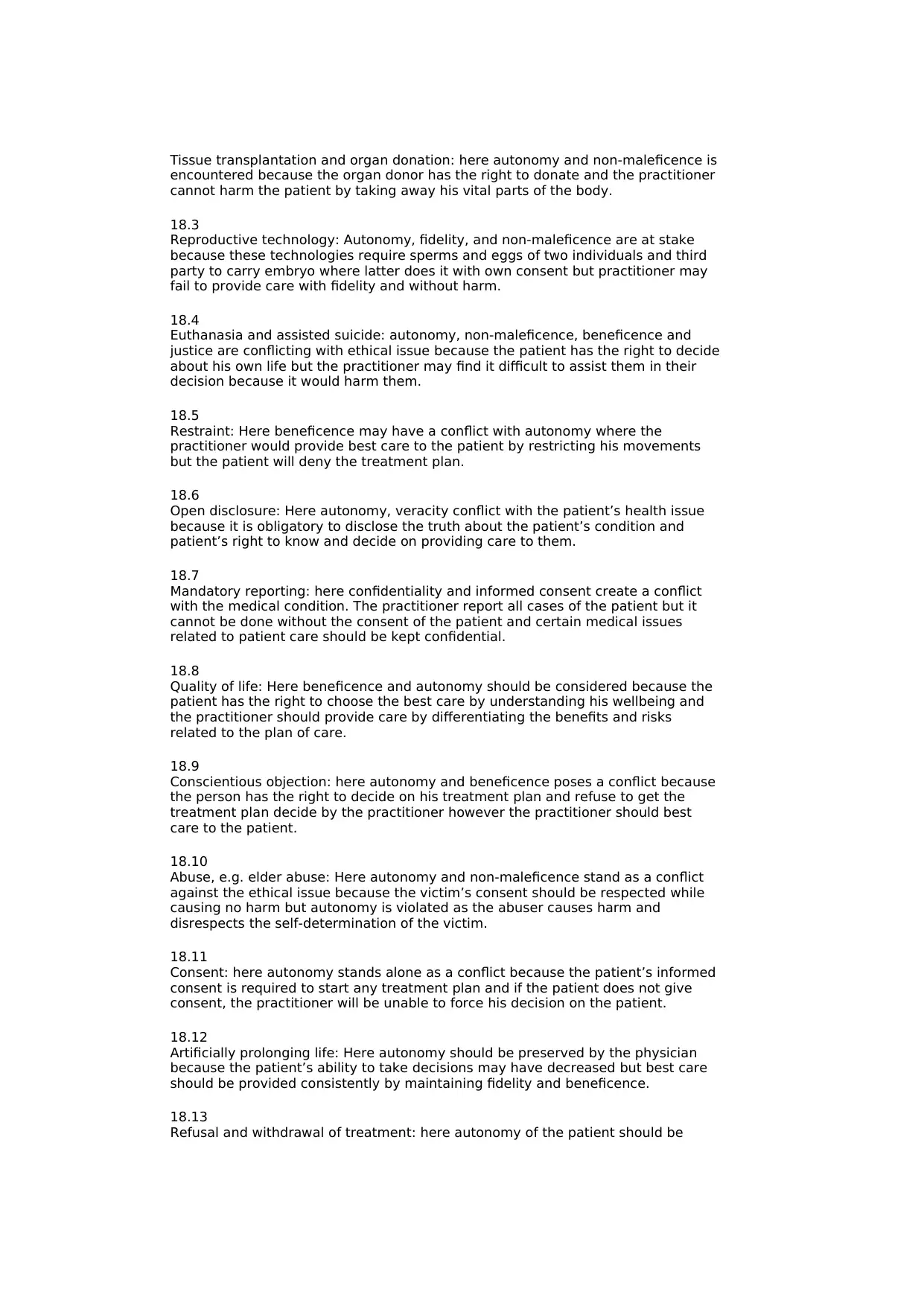
Tissue transplantation and organ donation: here autonomy and non-maleficence is
encountered because the organ donor has the right to donate and the practitioner
cannot harm the patient by taking away his vital parts of the body.
18.3
Reproductive technology: Autonomy, fidelity, and non-maleficence are at stake
because these technologies require sperms and eggs of two individuals and third
party to carry embryo where latter does it with own consent but practitioner may
fail to provide care with fidelity and without harm.
18.4
Euthanasia and assisted suicide: autonomy, non-maleficence, beneficence and
justice are conflicting with ethical issue because the patient has the right to decide
about his own life but the practitioner may find it difficult to assist them in their
decision because it would harm them.
18.5
Restraint: Here beneficence may have a conflict with autonomy where the
practitioner would provide best care to the patient by restricting his movements
but the patient will deny the treatment plan.
18.6
Open disclosure: Here autonomy, veracity conflict with the patient’s health issue
because it is obligatory to disclose the truth about the patient’s condition and
patient’s right to know and decide on providing care to them.
18.7
Mandatory reporting: here confidentiality and informed consent create a conflict
with the medical condition. The practitioner report all cases of the patient but it
cannot be done without the consent of the patient and certain medical issues
related to patient care should be kept confidential.
18.8
Quality of life: Here beneficence and autonomy should be considered because the
patient has the right to choose the best care by understanding his wellbeing and
the practitioner should provide care by differentiating the benefits and risks
related to the plan of care.
18.9
Conscientious objection: here autonomy and beneficence poses a conflict because
the person has the right to decide on his treatment plan and refuse to get the
treatment plan decide by the practitioner however the practitioner should best
care to the patient.
18.10
Abuse, e.g. elder abuse: Here autonomy and non-maleficence stand as a conflict
against the ethical issue because the victim’s consent should be respected while
causing no harm but autonomy is violated as the abuser causes harm and
disrespects the self-determination of the victim.
18.11
Consent: here autonomy stands alone as a conflict because the patient’s informed
consent is required to start any treatment plan and if the patient does not give
consent, the practitioner will be unable to force his decision on the patient.
18.12
Artificially prolonging life: Here autonomy should be preserved by the physician
because the patient’s ability to take decisions may have decreased but best care
should be provided consistently by maintaining fidelity and beneficence.
18.13
Refusal and withdrawal of treatment: here autonomy of the patient should be
encountered because the organ donor has the right to donate and the practitioner
cannot harm the patient by taking away his vital parts of the body.
18.3
Reproductive technology: Autonomy, fidelity, and non-maleficence are at stake
because these technologies require sperms and eggs of two individuals and third
party to carry embryo where latter does it with own consent but practitioner may
fail to provide care with fidelity and without harm.
18.4
Euthanasia and assisted suicide: autonomy, non-maleficence, beneficence and
justice are conflicting with ethical issue because the patient has the right to decide
about his own life but the practitioner may find it difficult to assist them in their
decision because it would harm them.
18.5
Restraint: Here beneficence may have a conflict with autonomy where the
practitioner would provide best care to the patient by restricting his movements
but the patient will deny the treatment plan.
18.6
Open disclosure: Here autonomy, veracity conflict with the patient’s health issue
because it is obligatory to disclose the truth about the patient’s condition and
patient’s right to know and decide on providing care to them.
18.7
Mandatory reporting: here confidentiality and informed consent create a conflict
with the medical condition. The practitioner report all cases of the patient but it
cannot be done without the consent of the patient and certain medical issues
related to patient care should be kept confidential.
18.8
Quality of life: Here beneficence and autonomy should be considered because the
patient has the right to choose the best care by understanding his wellbeing and
the practitioner should provide care by differentiating the benefits and risks
related to the plan of care.
18.9
Conscientious objection: here autonomy and beneficence poses a conflict because
the person has the right to decide on his treatment plan and refuse to get the
treatment plan decide by the practitioner however the practitioner should best
care to the patient.
18.10
Abuse, e.g. elder abuse: Here autonomy and non-maleficence stand as a conflict
against the ethical issue because the victim’s consent should be respected while
causing no harm but autonomy is violated as the abuser causes harm and
disrespects the self-determination of the victim.
18.11
Consent: here autonomy stands alone as a conflict because the patient’s informed
consent is required to start any treatment plan and if the patient does not give
consent, the practitioner will be unable to force his decision on the patient.
18.12
Artificially prolonging life: Here autonomy should be preserved by the physician
because the patient’s ability to take decisions may have decreased but best care
should be provided consistently by maintaining fidelity and beneficence.
18.13
Refusal and withdrawal of treatment: here autonomy of the patient should be
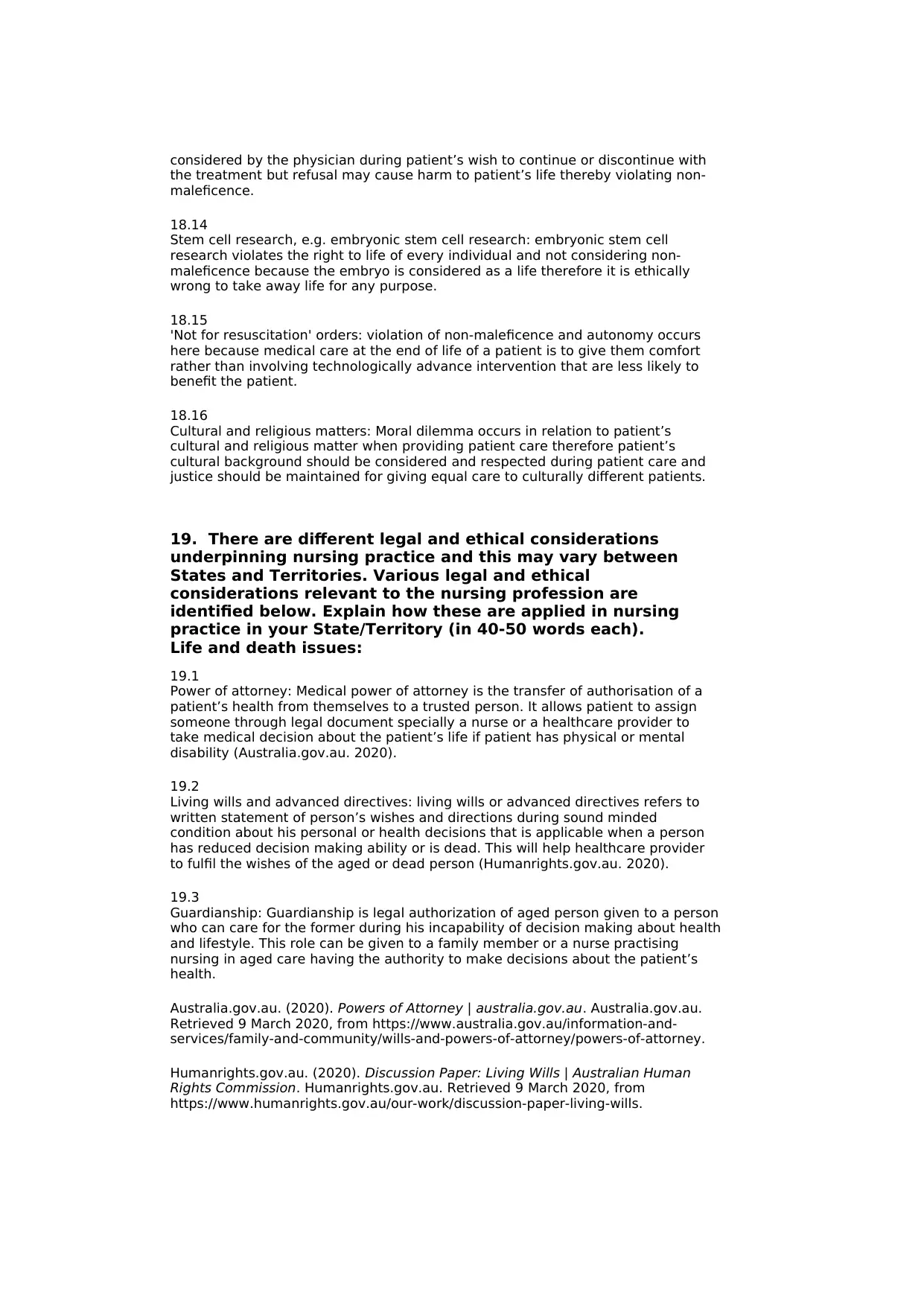
considered by the physician during patient’s wish to continue or discontinue with
the treatment but refusal may cause harm to patient’s life thereby violating non-
maleficence.
18.14
Stem cell research, e.g. embryonic stem cell research: embryonic stem cell
research violates the right to life of every individual and not considering non-
maleficence because the embryo is considered as a life therefore it is ethically
wrong to take away life for any purpose.
18.15
'Not for resuscitation' orders: violation of non-maleficence and autonomy occurs
here because medical care at the end of life of a patient is to give them comfort
rather than involving technologically advance intervention that are less likely to
benefit the patient.
18.16
Cultural and religious matters: Moral dilemma occurs in relation to patient’s
cultural and religious matter when providing patient care therefore patient’s
cultural background should be considered and respected during patient care and
justice should be maintained for giving equal care to culturally different patients.
19. There are different legal and ethical considerations
underpinning nursing practice and this may vary between
States and Territories. Various legal and ethical
considerations relevant to the nursing profession are
identified below. Explain how these are applied in nursing
practice in your State/Territory (in 40-50 words each).
Life and death issues:
19.1
Power of attorney: Medical power of attorney is the transfer of authorisation of a
patient’s health from themselves to a trusted person. It allows patient to assign
someone through legal document specially a nurse or a healthcare provider to
take medical decision about the patient’s life if patient has physical or mental
disability (Australia.gov.au. 2020).
19.2
Living wills and advanced directives: living wills or advanced directives refers to
written statement of person’s wishes and directions during sound minded
condition about his personal or health decisions that is applicable when a person
has reduced decision making ability or is dead. This will help healthcare provider
to fulfil the wishes of the aged or dead person (Humanrights.gov.au. 2020).
19.3
Guardianship: Guardianship is legal authorization of aged person given to a person
who can care for the former during his incapability of decision making about health
and lifestyle. This role can be given to a family member or a nurse practising
nursing in aged care having the authority to make decisions about the patient’s
health.
Australia.gov.au. (2020). Powers of Attorney | australia.gov.au. Australia.gov.au.
Retrieved 9 March 2020, from https://www.australia.gov.au/information-and-
services/family-and-community/wills-and-powers-of-attorney/powers-of-attorney.
Humanrights.gov.au. (2020). Discussion Paper: Living Wills | Australian Human
Rights Commission. Humanrights.gov.au. Retrieved 9 March 2020, from
https://www.humanrights.gov.au/our-work/discussion-paper-living-wills.
the treatment but refusal may cause harm to patient’s life thereby violating non-
maleficence.
18.14
Stem cell research, e.g. embryonic stem cell research: embryonic stem cell
research violates the right to life of every individual and not considering non-
maleficence because the embryo is considered as a life therefore it is ethically
wrong to take away life for any purpose.
18.15
'Not for resuscitation' orders: violation of non-maleficence and autonomy occurs
here because medical care at the end of life of a patient is to give them comfort
rather than involving technologically advance intervention that are less likely to
benefit the patient.
18.16
Cultural and religious matters: Moral dilemma occurs in relation to patient’s
cultural and religious matter when providing patient care therefore patient’s
cultural background should be considered and respected during patient care and
justice should be maintained for giving equal care to culturally different patients.
19. There are different legal and ethical considerations
underpinning nursing practice and this may vary between
States and Territories. Various legal and ethical
considerations relevant to the nursing profession are
identified below. Explain how these are applied in nursing
practice in your State/Territory (in 40-50 words each).
Life and death issues:
19.1
Power of attorney: Medical power of attorney is the transfer of authorisation of a
patient’s health from themselves to a trusted person. It allows patient to assign
someone through legal document specially a nurse or a healthcare provider to
take medical decision about the patient’s life if patient has physical or mental
disability (Australia.gov.au. 2020).
19.2
Living wills and advanced directives: living wills or advanced directives refers to
written statement of person’s wishes and directions during sound minded
condition about his personal or health decisions that is applicable when a person
has reduced decision making ability or is dead. This will help healthcare provider
to fulfil the wishes of the aged or dead person (Humanrights.gov.au. 2020).
19.3
Guardianship: Guardianship is legal authorization of aged person given to a person
who can care for the former during his incapability of decision making about health
and lifestyle. This role can be given to a family member or a nurse practising
nursing in aged care having the authority to make decisions about the patient’s
health.
Australia.gov.au. (2020). Powers of Attorney | australia.gov.au. Australia.gov.au.
Retrieved 9 March 2020, from https://www.australia.gov.au/information-and-
services/family-and-community/wills-and-powers-of-attorney/powers-of-attorney.
Humanrights.gov.au. (2020). Discussion Paper: Living Wills | Australian Human
Rights Commission. Humanrights.gov.au. Retrieved 9 March 2020, from
https://www.humanrights.gov.au/our-work/discussion-paper-living-wills.

Paraphrase This Document
Need a fresh take? Get an instant paraphrase of this document with our AI Paraphraser

1 out of 14
Related Documents
Your All-in-One AI-Powered Toolkit for Academic Success.
+13062052269
info@desklib.com
Available 24*7 on WhatsApp / Email
![[object Object]](/_next/static/media/star-bottom.7253800d.svg)
Unlock your academic potential
© 2024 | Zucol Services PVT LTD | All rights reserved.





